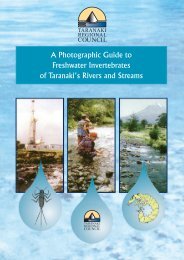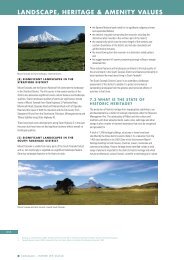Annual report 2006-2007 - Taranaki Regional Council
Annual report 2006-2007 - Taranaki Regional Council
Annual report 2006-2007 - Taranaki Regional Council
You also want an ePaper? Increase the reach of your titles
YUMPU automatically turns print PDFs into web optimized ePapers that Google loves.
26<br />
Biological survey<br />
The <strong>Council</strong>’s standard ‘kick-sampling’ technique was used at seven sites to collect<br />
streambed macroinvertebrates from the Kahouri Stream and an unnamed tributary<br />
on 17 April <strong>2007</strong>. Samples were sorted and identified to provide the number of taxa<br />
(richness), MCI and SQMCIS scores for each site.<br />
The MCI is a measure of the overall sensitivity of the macroinvertebrate community<br />
to the effects of organic pollution in stony streams. It is based on the<br />
presence/absence of taxa with varying degrees of sensitivity to environmental<br />
conditions. It may be used in soft-bottomed streams to detect trends over time. The<br />
SQMCIS takes into account taxa abundance as well as sensitivity to pollution, and<br />
may reveal more subtle changes in communities, particularly if non-organic impacts<br />
are occurring.<br />
Significant differences in either MCI or SQMCIS between sites indicate the degree of<br />
adverse effects (if any) of discharges being monitored.<br />
This summer survey of macroinvertebrate communities in the Kahouri Stream<br />
indicated that the communities directly downstream of the tributary that receives the<br />
<strong>Taranaki</strong> Abattoirs and Ballance Agri-Nutrients discharges were significantly<br />
different than those upstream. Taxa richness and MCI score were slightly healthier<br />
than median community conditions recorded previously at the ‘control’ site. There<br />
was a significant decrease in MCI and SQMCIS scores at the lower site, which may<br />
have been due to additional instream nutrients supplied by the tributary. This is<br />
likely to be due to the impacts from the abattoir, but this is unclear without further<br />
monitoring. Therefore it is recommended that additional sites be included in<br />
subsequent surveys to assess the impact of the abattoir discharge on this unnamed<br />
tributary.<br />
Further downstream at Flint Road, the macroinvertebrate community remained very<br />
similar in community structure and indicated similar stream ‘health’, although there<br />
was a recovery in the SQMCIS score at this site. None of the rest of the Kahouri<br />
Stream sampling sites further downstream showed any significant adverse effects as<br />
a result of industrial discharges to this catchment, consistent with the absence of any<br />
significant heterotrophic growths on the stream substrate.<br />
The macroinvertebrate communities of the Kahouri Stream were generally<br />
characterised by moderate taxonomic richnesses at the time of this April <strong>2007</strong> survey<br />
despite a period of relatively low flows during the latter part of summer. These<br />
communities continued to support abundances of several ‘sensitive’ taxa at all main<br />
stream sites, from upstream of the <strong>Taranaki</strong> Abattoir, to the confluence with the<br />
Piakau Stream. All sites had relatively similar communities, particularly in terms of<br />
those taxa characteristic to each site. For example, eight taxa dominated the<br />
communities of nearly all of the six Kahouri Stream sites.<br />
Most MCI scores were similar to historical median MCI scores, and higher SQMCIs<br />
scores than historical medians were recorded throughout the stream. There was some<br />
longitudinal deterioration throughout the catchment, a trend which is usually<br />
present in agricultural ringplain catchments due to non-point source discharges and<br />
is demonstrated by decreasing median MCI and SQMCIs scores in a downstream














